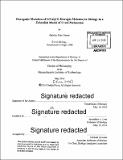Oncogenic mutation of GNAQ/11 disrupts melanocyte biology in a Zebrafish model of uveal melanoma
Author(s)
Pérez, Dahlia E
DownloadFull printable version (17.05Mb)
Other Contributors
Massachusetts Institute of Technology. Department of Biology.
Advisor
Jacqueline A. Lees.
Terms of use
Metadata
Show full item recordAbstract
Uveal melanoma (UM) is the most common primary intraocular cancer in humans. These tumors arise from nonclassical melanocytes found in the choroid, iris, and ciliary body (collectively called the uvea). Over 80% of UM tumors contain activating mutations in one of two genes encoding the homologous G[alpha] proteins GNAQ or GNA 11, which are the [alpha subunit of a heterotrimeric G protein receptor. Here we report that we have successfully used Tol-mediated transgenesis to develop a zebrafish model of UM driven by melanocyte specific expression of human oncogenic GNAQ/11Q 209L alleles. In cooperation with tp53M214K/M214K mutation, these GNAQ/11Q 209L transgenic zebrafish develop both uveal and cutaneous melanomas with nearly complete penetrance, causing early lethality. Furthermore, immunohistochemical analysis (IHC) reveals that these melanomas do indeed recapitulate the human disease in that they drive expression of oncogenic GNAQ and show increased expression of YAP. Interestingly, the transgenic zebrafish display an array of internal and external pigmentation defects compared to nontransgenic clutchmate controls. These pigment defects are independent of tp53 mutation. Zebrafish stripe patterning has been previously exploited to elucidate mechanisms in melanocyte signaling; therefore, to learn about the consequences of oncogenic GNAQ/1 1 signaling in melanocytes we pursued in vivo and in vitro study of transgenic melanocytes. The in vivo pigment phenotypes in these mutants include hyperpigmentation, mislocalized melanocyte and aberrant melanocyte morphology, and are detectable through all developmental phases beginning as early as 3 days post fertilization. In vitro, upon transgene expression the mutant melanocytes exhibit increased dendricity, motility, and survival. To understand the mechanisms underlying these phenotypes, we performed RNAseq on transgenic and nontransgenic melanocyte populations. Transcriptome analysis revealed a list of 353 differentially expressed genes. Functional analysis of this gene set implied changes in categories related to axon guiding, cell adhesion and cell cycle regulation. Taken together, our results reveal that persistent alterations in melanocyte biology occur as a result of oncogenic GNAQ/11 expression in a novel zebrafish model of UM. These observations provide the ground work for elucidating the mechanisms by which the oncogenic GNAQ/11 mutations are tumorigenic and for potentially generating therapies for this poorly understood disease.
Description
Thesis: Ph. D., Massachusetts Institute of Technology, Department of Biology, 2016. Cataloged from PDF version of thesis. Includes bibliographical references.
Date issued
2016Department
Massachusetts Institute of Technology. Department of BiologyPublisher
Massachusetts Institute of Technology
Keywords
Biology.